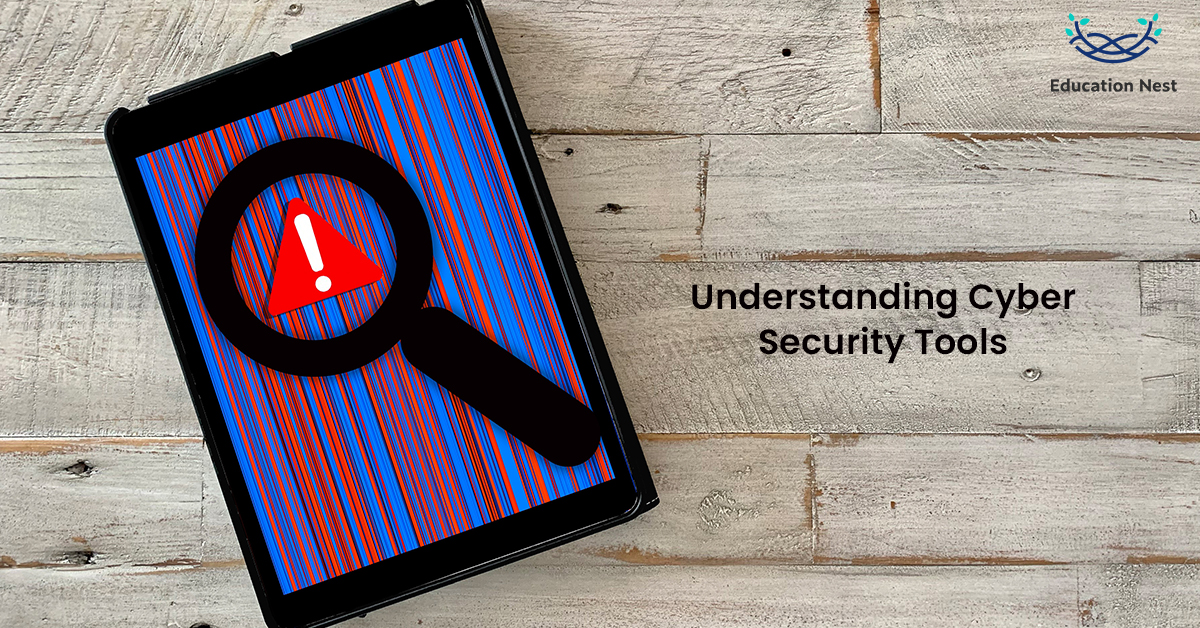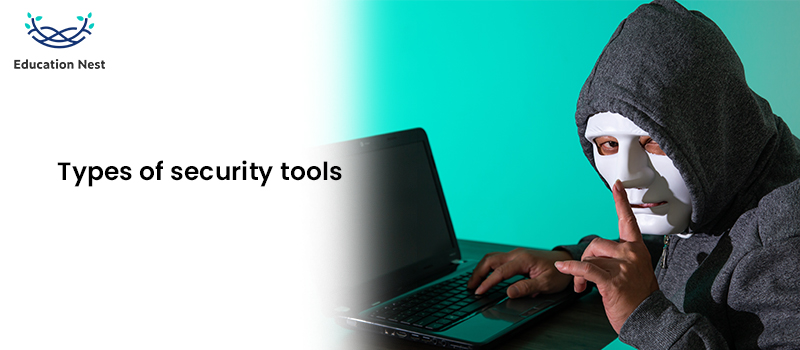
The technique used to defend against cyberattacks on the network, platform, or applications is known as cybersecurity. Cyber security tools is essential for the cyber security and privacy of a corporation or an individual. It serves as a defense against identity theft, cyberattacks, and unwanted data access.
A cyber security analyst can safeguard the privacy of the company’s data and avoid all types of compromised data, financial loss, etc., by using various technologies, whether paid, free, or open-source.
This manual serves as your first step toward a career in cyber security. Discover the types and tools that cybersecurity analysts most frequently employ.
Types of security tools

Cybersecurity Analysts use a variety of tools in their jobs. The majority of cyber security products fall into one of many categories. The following is a list of the categories into which these tools can be divided with an example of each:
- Penetration Testing Tools
Penetration testing commonly referred to as “pen testing,” mimics an attack on a computer to assess the system’s security.
Pen Testing enables Cyber Security professionals and Ethical Hackers to conduct targeted assaults against the company’s security architecture to detect any flaws or security vulnerabilities that should be rectified.
Tools for penetration testing include Netsparker, Metasploit, Kali Linux, and Wireshark.
- Kali Linux
One of the most widely used tools in cyber security is Kali Linux. A variety of tools included in this operating system are helpful for security audits, network and system vulnerability scanning, etc. Professional penetration testers, ethical hackers, and cybersecurity experts use Kali Linux.
One of the key benefits of this platform is that it can be used by Cyber Security experts of all levels of expertise, making it a great option even for entry-level professionals. Many of the tools Kali Linux provides are simply executable, enabling users to check the network security systems of the business with only one click.
Features of Kali Linux
- Supports multiple languages
- Pre-installed with more than 600 penetration testing tools
- Compatibility for a variety of wireless devices
- Encryption Tools
Using a key and an algorithm, the available material is converted into an encoded message that authorised individuals can only decode.
Text is scrambled during encryption to make it unintelligible to unauthorized users. This safeguards data.
Tor, AxCrypt, TrueCrypt, KeePass, VeraCrypt, and Nord Locker are all examples of encrypted tools.
- AxCrypt
AxCrypt has provided customers worldwide with powerful encryption that has been easy to understand for more than 20 years.
AxCrypt offers file protection with 128-bit or 256-bit encryption and cloud storage awareness with plans designed for individual users and businesses. Additionally, it includes important sharing capabilities that keep your data secure from expensive data breaches; while assisting companies in complying with data protection laws and regulations.
Features of AxCrypt
- It does not require an understanding of encryption.
- You can encode and decode files from your mobile devices using mobile encryption.
- Access and control your passwords
- Network Security Monitoring Tools
These tools are used to examine network data and find network-based threats. It keeps track of anything with an IP address and is linked to the network, including routers, switches, load balancers, wireless LAN controllers, firewalls, and servers.
Some examples of tools are Nagios, Pof, Splunk, Argus, and OSSEC.
- Nagios
The Nagios management software is a versatile, adaptable, and user-friendly choice for keeping an eye on and guaranteeing the integrity of your company’s infrastructure.
It guarantees to assist you in identifying and fixing any issues with your IT infrastructure before they impact your business procedures. It keeps constant watch over the hosts and associated systems. It immediately notifies users of any security problems or network intrusions by sending out an alert.
You Must Like: Understand and Create Heatmap in Power BI
Features of Nagios
- Monitoring of all essential infrastructure elements, such as programmes, operating systems, and network protocols
- Utilise self-operating, integrated trending and capacity management graphs to prepare for infrastructure upgrades.
- The enterprise edition’s advanced capabilities include automated host decommissioning, internet server console access, alert deployment, and SLA reports.
- Packet Sniffer Tools
The technique of capturing and examining each packet sent across the network is known as packet sniffing. Packet sniffing is typically used to acquire network information or resolve network issues.
A packet sniffer is a software that collects packet data. Network traffic and data are intercepted, logged, and analysed using packet sniffers.
Wireshark, Tcpdump, and Windump are some examples of tools.
- Wireshark
Wireshark is one of the top cybersecurity tools. It is a packet sniffer programme that enables experts to examine network protocols and detect live networks in search of exploitable weaknesses.
Professionals in cyber security use this method to store data packets and determine the traits and behaviours that each packet demonstrates. This information aids in locating network security weaknesses. In essence, it monitors network packets and understandably displays them.
Features of Wireshark:
- Live recording and offline evaluation
- Various capture file formats, such as tcpdump (libpcap), Catapult DCT2000, Microsoft Network Monitor, and many others, can be read and written.
- Detailed VoIP analysis
- Web Vulnerability Scan Tool
These software tools scan online applications for security flaws like path traversal, SQL injection, and cross-site scripting.
These scans provide a business with a better understanding of the security dangers they may be up against by revealing any potential security flaws in their surroundings. To guarantee that every asset is fully covered and a complete picture is created, many businesses employ numerous vulnerability scanners.
Tools like Burp Suite, Proxy, SQLMap Nikto, and Paros are a few examples.
- Burp Suite
Burp Suite is a comprehensive platform and graphical tool for evaluating the security of web applications. Its numerous tools all function in unison to help the testing process throughout, from fundamental analysis and mapping of the application’s attack surface to detecting and utilising security flaws.
Security professionals use Burp Suite to conduct real-time system scans and find critical risks that could seriously compromise a company’s security. Additionally, it simulates attacks to discover how these threats might erode and jeopardise the network’s security.
Features of Burp Suite
- Check manually for out-of-band weaknesses.
- Uncover a hidden attack surface
- Get rid of bugs efficiently.
- Network Intrusion Detection Tools
An Intrusion Detection System (IDS) keeps track of network and system activity for any odd or suspicious behaviour and warns the administrator if potential danger is seen.
The primary function of an IDS is to identify abnormal activity and notify the network administrator. However, some IDS software can act according to the rules when suspicious activity is discovered, such as blocking specific incoming traffic.
Tools like SolarWinds Security, Event Manager Kismet, Zeek, Security Onion, and Snort are a few examples.
- SolarWinds Security
SolarWinds provides a comprehensive selection of cybersecurity solutions to handle various tasks, including database administration, management systems, IT security and service management, and much more.
Without needing to establish a full-fledged Security Operations Center, SolarWinds assists in maintaining a secure operational environment (SOC). It aids in achieving and proving the required compliance in regulated businesses. It offers enterprise-level network and system security management without associated costs and complexity.
Features of SolarWinds
- Threat detection and reaction automation
- Central log gathering
- The Dashboard is simple to utilise
- Built-in monitoring of file integrity
- Compliance Reporting
- Forensic evaluation
- Information on cyber threats
Conclusion
Organizations now focus highly on cyber security because of the volume of private information and financial records regularly injected into their systems. Cybercrimes are rising due to the constant demand for technology to perform all tasks practically.
We looked at the best cybersecurity software tools to understand cybersecurity’s importance. We have also read extensively on a few of the most well-known and frequently used products in cyber security.
To have a competitive advantage when applying for jobs in this industry as a professional, it is crucial that you not only receive training in it but also learn how to operate some of these tools.

